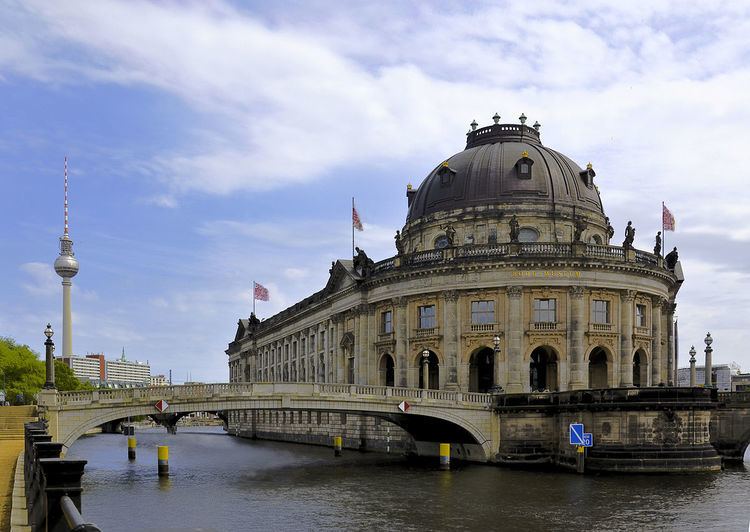Phone +49 30 266424242 | ||
 | ||
Hours Closed today MondayClosedTuesday10AM–6PMWednesday10AM–6PMThursday10AM–8PMFriday10AM–6PMSaturday10AM–6PMSunday10AM–6PM Similar Museum Island, Alte Nationalgalerie, Altes Museum, Pergamon Museum, Neues Museum Profiles | ||
Bode museum videoscout it
The Bode Museum is one of the group of museums on the Museum Island in Berlin, Germany. It was designed by architect Ernst von Ihne and completed in 1904. Originally called the Kaiser-Friedrich-Museum after Emperor Frederick III, the museum was renamed in honour of its first curator, Wilhelm von Bode, in 1956.
Contents
Collections
Closed for repairs since 1997, the museum was reopened on October 18, 2006 after a €156 million refurbishment. True to the ethos of its founding director, Wilhelm von Bode, who believed in mixing art collections, it is now the home for a collection of sculptures, Byzantine art, and coins and medals. The presentation of the collections is both geographic and chronological, with the Byzantine and Gothic art of northern and southern Europe displayed separately on the museum’s first floor and a similar regional division of Renaissance and Baroque art on its second floor.
The sculpture collection shows art of the Christian Orient (with an emphasis on Coptic Egypt), sculptures from Byzantium and Ravenna, sculptures of the Middle Ages, the Italian Gothic, and the early Renaissance. Late German Gothic works are also represented by Tilman Riemenschneider, the south German Renaissance, and Prussian baroque art up to the 18th century. In the future selected works of the Gemäldegalerie will be integrated into the sculpture collection. This is reminiscent of William von Bode's concept of "style rooms", in which sculptures, paintings, and crafts are viewed together, as was usual in upper middle-class private collections.
The Münzkabinett ("coin cabinet") is one of the world's largest numismatic collections. Its range spans from the beginning of minting in the 7th century BC in Asia Minor up to the present day. With approximately 500,000 items the collection is a unique archive for historical research, while its medal collection makes it an important art exhibition at the same time.
Writing in The Financial Times on the occasion on the museum's reopening in 2006, Neil MacGregor, director of the British Museum, hailed “the most comprehensive display of European sculpture anywhere.” He added: “It is no exaggeration to say that in the new Bode Museum, Europe will be able for the first time to read its history — aesthetic and religious, intellectual and political — in a three-dimensional form.”
The "Flora" bust
In 1910, it was revealed that a bust of Flora, which had been purchased by the Kaiser Friedrich Museum, Berlin, under the belief that it was by Leonardo da Vinci, may have actually been created by the English sculptor, Richard Cockle Lucas. Wilhelm von Bode, the general manager of the Prussian Art Collections for the Berlin Museum, had spotted the bust in a London gallery and purchased it for a few pounds. Bode was convinced that the bust was by Leonardo and the Berlin Museum authorities, and the German public, were delighted to have "snatched a great art treasure from under the very noses" of the British art world.
Shortly afterwards, The Times ran an article claiming that the bust was the work of Lucas, having been commissioned to produce it from a painting. Lucas's son, Albert, then came forward and swore under oath that the story was correct and that he had helped his father to make it. Albert was able to explain how the layers of wax had been built up from old candle ends; he also described how his father would stuff various debris, including newspapers, inside the bust. When the Berlin museum staff removed the base they found the debris, just as Albert had described it, including a letter dated in the 1840s.
Despite this evidence, Bode continued to claim that his original attribution was correct. To support this, he displayed the Flora bust among a selection of Lucas's lesser work – this exhibition rather backfired, however, as it showed that Lucas had been regularly making wax sculptures inspired by the great works of previous times.
Various claims and counter-claims have been put forward about the bust, from its being an outright forgery to being a genuine 16th-century piece (albeit not by Leonardo). Scientific examination has been inconclusive and unhelpful in dating the bust, although it is accepted as having at least some connection with Lucas. The bust remains on display in what is now the Bode Museum labelled "England", "19th Century" with a question mark.
Pop culture
The museum appears as a playable level in the World War II video game Sniper Elite V2.
